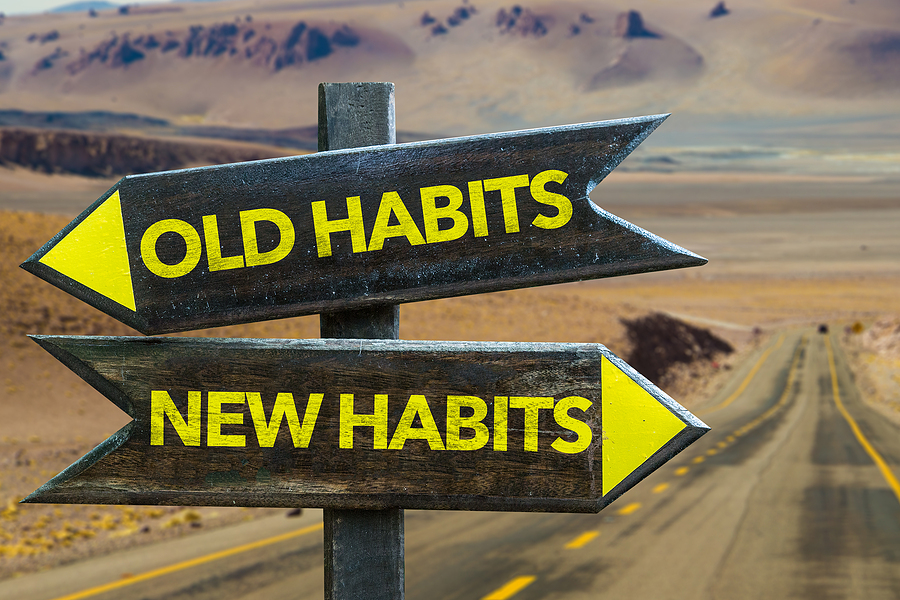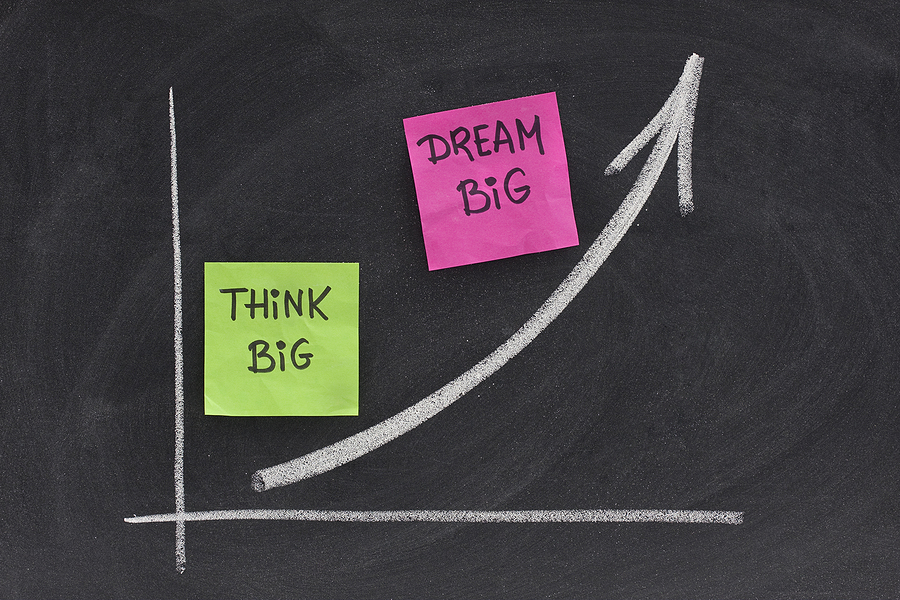Category Archives: Boosting Creativity, Productivity & Effectiveness
How to Change a Habit That is Hurting You, Part 3
Did you know that what might feel like a step backward can dramatically enhance your forward progress? It’s true, but only if done right. Here’s how.
The third step to changing a habit that’s hurting you is to notice how often you engage in the behavior you want to change and what the impact is when you do.
That can be rather painful, because you already know what habits you want to change and how they are hurting you. Yet chances are that you’re still engaging in them more often than you’d like – almost as though you cannot help yourself.
But you’re simply observing the effect of being on autopilot.
Your habits become defaults that allow you to do things without a lot of thought or effort. That’s a good thing when a behavior serves you, like brushing your teeth or working out in the morning. But when those engrained habits lead you to regret your actions later, you have to slow things down so that you’re more conscious of what you’re doing and where it’s getting you.
The good news is that initially, you don’t have to recognize what are often knee jerk reactions in the moment. You can replay the events in your mind later and recognize that you were in the grip of an automatic response.
You can notice what triggered the behavior. And you can begin to envision strategies for interrupting the pattern, like taking a breath, stepping away for a moment, and getting realigned with your true intention and desire.
In addition to what led you to engage in a problematic habit, pay attention to how you felt afterward. Recognize how it impacted the rest of your day, or week. Become aware of how it may have affected people you care about and made you feel about yourself.
The more pain you associate with behavior you seek to rise above, the stronger your commitment will become to rise above it.
Taking time regularly to mentally review your actions will help you catch yourself engaging in old behaviors that aren’t serving you. You’ll find that over time, you’ll go from realizing it hours or days later to recognizing it moments after it happened, to catching yourself in the act, and eventually to keeping yourself from doing it at all.
The steps I’ve been sharing with you over these last few days are a small part of what I teach and coach executives to implement in The Pinocchio Principle Unleashed, a thirteen-week, seven-module virtual leadership development program designed to help business professionals like you maximize your performance, minimize stress and pressure and enjoy a more fulfilling life both on and off the job (and lead others to do the same).
This process can be applied in many areas of your life to integrate your best and worst experiences in ways that allow you to leverage what you learn – and become stronger as a result.
Next week I’ll cover step four of How to Change a Habit That is Hurting You.
How to Change a Habit That is Hurting You, Part 2
You’ve made a commitment to yourself, and you are determined to change that self-defeating habit once and for all. What do you do next?
STEP TWO: Surround yourself with reminders of what you are moving toward.
Though you may not have already experienced the pleasure you will gain by moving beyond your old habit and engaging in something new, your mind can help you to imagine it and make it real for you. It does this in much the same way that it can also magnify your fears and come up with all kinds of scenarios that could have you shaking in your boots.
Take control of your mind in advance. Envision the change you are making and what you imagine it will bring you.
If you are trying to get control of your temper, imagine what it will feel like to be able to calmly engage in discussion with someone without losing your head. Envision yourself shaking hands with people and leaving meetings feeling as though you have strengthened relationships rather than damaged them.
See if you can find a symbol or image that helps you to move into that feeling whenever you look at it. And put that visual reminder somewhere where you will see it often.
Maybe you are wanting to break the habit of staying in your comfort zone rather than taking the bold actions you dream about – like expanding your business, going after a new market, creating a new program or product, or creating and empowering a solid team that can do more together than you ever could alone.
Envision what acting on your dream will give you and see if you can experience it in your mind as though it has already happened.
Find pictures that evoke those feelings for you and get you excited and motivated to take steps to make it happen. Look at them every day, several times a day and feel those feelings when you do.
The key to transformation comes when you move from seeing the future you want to create to embodying it.
When you feel as though you are getting sucked back into old behaviors you are trying to leave behind, or when you are discouraged about your progress use your reminders to bring you back to your intention and recommit to yourself. Then take action in the new direction you want to move in.
The steps I’ve been sharing with you over these last few days are a small part of what I teach and coach executives to implement in The Pinocchio Principle Unleashed, a thirteen-week, a seven-module virtual leadership development program designed to help business professionals like you maximize your performance, minimize stress and pressure and enjoy a more fulfilling life both on and off the job (and lead others to do the same).
There is a whole lesson dedicated to visioning and embodying your future that participants have told me has been instrumental in helping them create and achieve what they most want to achieve and experience. Message me if you’d like more information.
Next week, I’ll share step three of How to Change a Habit That is Hurting You.
Here’s to your success!
How to Change a Habit That is Hurting You, Part 1
The first step to changing a habit may be working against you is to make a decision, a declaration and a commitment to yourself.
 There is power in willingness. I’m talking about more than good intentions here, though that is where it all starts. People are at the threshold of change when the pain of one behavior becomes greater than its payoff. But for that momentum to take hold, the perceived payoff of the change must be greater than the seeming pain of giving something up.
There is power in willingness. I’m talking about more than good intentions here, though that is where it all starts. People are at the threshold of change when the pain of one behavior becomes greater than its payoff. But for that momentum to take hold, the perceived payoff of the change must be greater than the seeming pain of giving something up.
The trouble is you may not really know what that payoff will be. And though you also may not know what that change will entail, your mind will be off and running creating scenarios that have you believing it’ll be far harder than anything you can imagine.
And that can become a real showstopper if you aren’t ready for it.
It’ll keep you from getting out of bed in the morning. It’ll have you playing small when you are on the verge of bold, courageous action. It’ll make the old beaten path you’ve been traveling seem preferable to heading into the uncertainty of whether you will be able to do whatever you are learning to do in place of your old behavior.
So, you have to make a commitment to yourself.
You must get really clear in your mind that you will no longer tolerate your old way of doing things and decide that you will do whatever it takes to move beyond it.
It helps if you write it down. And it also helps if you tell someone else about it – someone who can remind you of all the reasons you are doing it, of what you have to gain, and of what you are rising above and why.
Think about a habit you would like to move beyond.
- How has it been hurting your effectiveness? Your credibility? Your peace of mind?
- What would you gain by rising above it?
- What could you do if you no longer fell into that pattern of behavior?
- How would you feel?
Are you ready to make a change?
If so, make a commitment right now to yourself. Write it down and then share it with someone who will support you as you endeavor to carry that commitment out.
As promised, in coming weeks I’ll continue to deliver to you a five-step process for changing habits that are getting in the way of your success – the impact you can make and the satisfaction and fulfillment you can enjoy both on and off the job.
These steps are a small part of what I teach and coach executives to implement in The Pinocchio Principle Unleashed, a thirteen-week, seven-module virtual leadership development program designed to help business professionals like you maximize your performance, minimize stress and pressure, and enjoy a more fulfilling life both on and off the job (and lead others to do the same).
Next week I’ll share with you the second step to breaking a habit that is hurting you.
Here’s to your success!
Are Your Habits Hurting You?
Often, we don’t seek help until things begin to hurt us. And though it’s unfortunate that we wait until things become painful to try something different – it is often just the springboard we need to find better ways of doing and being.
- Maybe your last temper explosion led people to no longer want to support you, and you are ready to figure out ways of better channeling your anger.
- Maybe you have totally burned yourself out and are starting to realize that there has to be a better way of doing things.
- Or perhaps you’ve finally realized you’re never going to be able to sustain your success and take your game to a new level as a leader of others if you insist on doing everything yourself.
When your habits begin to hurt you, you get to decide what you are going to do about them. It’s a crossroads that can be challenging – because though you might be experiencing pain and discomfort with your habit, it likely will seem as though anything you might need to do differently will be even worse. And that is the root of resistance.
But what I have found through my own experience, as well as that of so many others – friends, clients, colleagues – is that the pain caused by resistance is far worse than anything it would have you avoid.
Maybe you don’t need to wait until it comes to a head.
We all have habits that no longer serve us. And you already likely know what habit (or habits) are bringing you down. So, the question is, what are you going to do about it?
Over the next few weeks, I’ll be walking you through a five-step process for changing the habits that hurt you. It’s a small part of what I teach in the Pinocchio Principle Unleashed, a seven-module virtual leadership development program designed to help business professionals like you maximize your performance, minimize stress and pressure and enjoy a more fulfilling life both on and off the job (and lead others to do the same).
For now, take stock of the things you do on autopilot that may not necessarily be in your best interest – and begin to notice any negative impact those behaviors may be having on your work or in your life. Making needed change in those areas could yield rich dividends. And it all starts with conscious awareness and a willingness to consider doing things differently.
“When we are attentive to our actions, we are not prisoners of our habits.” – T. K. V. Desikachar
How to Get Those Engines Running Again
Over the last several weeks I’ve been posting tips for leaving and returning from vacation. I took my own advice and prepared those articles to go out while I was enjoying some out of office time of my own.
But now I’m back. And I had a few more insights about how to get back in the swing of things as I navigated my own re-entry. This week’s video features four tips that helped me get back into my groove – and I’m confident they will help you too.
While these suggestions are timely after you’ve returned from being away from the office, they are also entirely fitting for anytime you are having trouble getting something done, approaching a project you’ve been putting off, or stuck in the middle of something that has you feeling stalled.
Here’s to coming back better and brighter!
Diane
How Your Vacation Can Keep on Giving (long after you return)
If you worry that taking vacation might lead you to lose focus or traction with your work, you’re not alone. But…. What if you could actually improve your focus, ingenuity and performance BECAUSE you spent time away?
Last week I posted about the first step for coming back strong after your vacation: (1) Take a moment to get clear on what you most want.
Today, we’ll explore the second strategy…
 (2) Take advantage of the opportunity to see things with a fresh perspective.
(2) Take advantage of the opportunity to see things with a fresh perspective.
Being creatures of habit, we tend to jump back into the same ways of doing things that led us to feel like we desperately needed a vacation in the first place. Going on vacation creates a pattern interrupt that you can leverage in your work.
In much the same way a new employee sees problems and solutions from a different angle than the more seasoned team members, your time away allows you to view your work with new eyes.
Notice what’s going through your head without allowing it to disturb your peace of mind.
- Are you frustrated that things didn’t run as smoothly as you wanted them to while you were away?
- Is there a voice screaming at you to jump in and start answering emails, returning calls and/or wading through piles of paper before you lose another minute?
- Are you feeling burdened by the weight of what seems to be more than you can humanly process in the span of a day/week/month?
These thoughts are to be expected. We all have them. But they don’t have to push you into a panic-filled, adrenaline-provoked response that keeps you from being effective. A lot of our stress is a result of comparing what is happening to what we think should happen, which takes us out of the moment and puts us in a battle in our heads, adding unnecessary stress and pressure.
Instead, come back to the moment and see if you can simply assess it without judging.
Be mindful of telling yourself stories about what it means, or what is going to happen next. Before you jump into action, do an assessment of all the things that are competing for your attention. Don’t think of this as a “to do” list, just an inventory of potential items to be addressed. Add to it anything else that you feel compelled to act on.
Getting things out of your head frees your mind to utilize discernment, so that you can sort through what would otherwise overwhelm you and identify what your true priorities are. In my next post, I’ll talk you through a way to do just that.
And if you want to learn to infuse your work year-round with the same freshness and inspiration you feel after a good vacation, message me to learn about a new program I’ll soon be making available to a limited number of executives.
How To Set Yourself (and Others) Up for Success on Your Next Vacation
Want to get away? Of course you do. And you SHOULD! Letting your vacation time go unused doesn’t benefit you OR your organization because you’ll miss out on ways to supercharge your success by replenishing your vital reserves of energy, creativity and resilience.
Over the past few weeks, I’ve shared strategies for disconnecting from work while you are on vacation so that you can not only enjoy your time away but also maximize your ability to return refreshed and ready to roll.
(3) Set and communicate boundaries and expectations in advance.
Most of us are accustomed to setting up automated “out of office” messages in our mailboxes. But we often fail to communicate and manage expectations in advance. As a result, people can feel caught off guard and demanding of your time while you are away. Or you can feel inclined to respond to something that really isn’t all that urgent out of fear of damaging a relationship or letting a ball drop.
 Take the time to talk with others about your intention to completely disconnect from work on vacation.
Take the time to talk with others about your intention to completely disconnect from work on vacation.
Make it clear that you do not intend to check email or handle phone calls. Remind them of the guidelines you’ve set on what to do in your absence. And clarify your intention to use this time to replenish your reserves so that upon your return you can more effectively serve them.
When clients believe they will be well cared for and know who in your organization to contact for what, they are much less inclined to interrupt you. If you discuss in advance what things can be done before and while you are gone and what is better delayed until your return, you’ll be able to leave with the peace of mind that everyone is on the same page.
Don’t underestimate the power of your example.
Leaders set the tone in organizations more by what they do than what they say. If you interrupt your vacations to get involved in work, others are likely to feel compelled to follow suit. As a result, the energy of your team wanes, tempers flare, and performance begins to decline. People work harder than ever but don’t seem to get a lot done, or they burn out altogether.
When you apply solid strategies for how to disconnect from work on vacation, you’ll exercise true leadership – showing others how to truly revitalize themselves and their performance by modeling it yourself.
If you want to learn to infuse your work year-round with the same freshness and inspiration you feel after a good vacation, message me to learn about a new program I’ll soon be making available to a limited number of executives.
In coming weeks, I’ll share strategies for post vacation re-entry… 3 steps for coming back strong.
One of The Most Important Decisions You’ll Ever Make
 Have you ever noticed that pressure, volatility, and uncertainty lead people to revert to primitive behavior? In the grip of it, they prioritize their own needs over those of others, let fear and anxiety call the shots, and short circuit their ability to think clearly (or at all).
Have you ever noticed that pressure, volatility, and uncertainty lead people to revert to primitive behavior? In the grip of it, they prioritize their own needs over those of others, let fear and anxiety call the shots, and short circuit their ability to think clearly (or at all).
It happens to all of us.
The more it holds your attention, the more likely you are to continue falling down that rabbit hole. Your focus shifts to…
…what you’re afraid of (or want to avoid)
…what’s out of your control
…what brings you down
…what you lack
…doubt and skepticism
…worry, anxiety, and preoccupations
…judgement and set stories about how things are
That mindset becomes a prevailing force that’ll keep you stuck because in that state you’ll cut yourself off from the stronger, wiser part of yourself – what I call your Genius.
But with conscious intention and commitment, you can interrupt that process and become the leader that helps others escape from and avoid that trap.
It all starts by shifting your focus…
…from what you want to minimize or move away from to what you want to move toward
…from getting something (for yourself) to giving something (to others)
…from doubt to confidence (in yourself, others, and life itself)
…from what’s beyond your control to what you can influence
…from worry, anxiety, and preoccupation to the present moment and trust in the process
…from what brings you down (irritation) to what amps you up (appreciation), and
…from judgement and stories about how things are to curiosity, learning, and growth
When you move from the concerns of your ego to access your Genius (higher nature), you’ll have a very different experience too.
You’ll enjoy:
- The energy and vitality to perform at your highest level without getting beaten down by stress, pressure, and overwhelm,
- A renewed passion and sense of meaning that gives you the strength to overcome obstacles and resilience to bounce back from setbacks,
- Heightened creativity and ingenuity to find answers to problems that previously stumped you – and to navigate change, challenge, and uncertainty with courage, confidence, and ease, and
- The ability to create strong connections with people that inspire trust and increase your ability to influence and truly lead.
It all begins with conscious awareness of where you are and where you want to be and a willingness to intentionally shift your focus in ways that allow you to bridge that gap.
We all have the ability to lead ourselves and others above circumstances that would otherwise keep us down, and there is never a better time to start than now.
3 Steps for Escaping the Hamster Wheel

Do you find yourself running from one thing to the next with little time to think about what you’re doing and why?
If you said yes, you’re not alone.
Many high achieving professionals feel they have way more to do than time to do it. Their ambition, drive, and passion have served them well, but they know they’re capable of more. More opportunity, more impact, and dare I say – more freedom to enjoy their careers and their lives.
The daily grind keeps us tethered to the ground, thinking our best is just around the corner if only we can get through what’s in front of us – often an accumulation of projects and commitments that grows far faster than it shrinks. Occasionally, it becomes apparent that something’s got to give.
But who has time to slow down when there’s so much more to get done?
The fantasy many of us have bought into is that if we just work longer and harder, we will get there. And despite our longing to find balance and the sweet spot that will finally allow us to relax and be more effective, we often act in ways that bring greater levels of anxiety and toil.
As leaders, we also unwittingly create entire cultures of people who emulate our frenetic behavior in the name of getting ahead.
The hamster in the wheel doesn’t know he isn’t getting anywhere.
And before he can, he must realize that he is, in fact, in a wheel. Our wheels are much more sophisticated and deceiving than those of the hamster. Because initially, our wheels do get us somewhere. It’s just that over time, they lose traction and become stuck in comfortable ruts.
And we don’t realize when we’re stuck, because it doesn’t seem possible to be standing still when you’re running like hell.
How willing are you to recognize that perhaps there is a better way?
All change begins with awareness coupled with desire. To move beyond your madness, try the following:
- Pay attention when you’re feeling anxious, stressed, or tense. Recognize the thought or behavior pattern that may be causing this discomfort. This may be a prime area for a shift.
- Ask yourself some discerning questions such as, “What small, but powerful change could I make today that would allow me to be more effective?” Open your mind to different approaches, processes and greater discernment about what really must be done, when, and by whom.
- Notice what catches your attention in the coming days. The answers to your questions will reveal themselves to you, but you must hold the intention to receive them and be willing to listen.
Once you recognize the patterns and triggers that perpetuate your anxiety, stress, and pressure – and the impact they’re having in your life, they begin to lose their hold on you. As they fall away, you can escape the hamster wheel and take the kind of inspired action that’ll get you where you REALLY want to go.
Here’s to your success!
Gripped by Fear, Anger or Frustration? Get Back into Your Right Mind
We’ve all been there… someone says or does something that triggers you – or things take an unexpected turn for the worse and you can’t help but react. Your heart begins to beat wildly, your breathing gets shallow and choppy, and your body tenses up.
It’s called an amygdala hijack. And it literally disables your rational mind – the part of you that makes decisions, controls your reactions, and allows you to problem solve.
Though the physiological symptoms may only last for seconds or minutes, your ability to think clearly may be reduced for hours. And the thoughts and actions you’re likely to take in its grip could prolong a state of fear, anger or frustration for hours, days and even weeks.
This is because the aperture of your lens becomes so narrow that you’ll only perceive a small fraction of the entire picture. In this state, you’re likely to…
…put your attention on what is wrong, rather than what is right.
…spend more time and energy on describing, complaining about, and magnifying the problem than finding the solution.
…be more concerned with what you can get rather than what you can give.
…focus more on what’s out of your control than on what you can influence.
…feel helpless rather than hopeful – and act in ways that lead others to feel that way too.
But each of us has the power to turn that around. And doing so is an act of leadership – regardless of your job title, industry or profession. Here are three simple steps you can take:
1) Take some deep breaths.Get oxygen flowing back into your cells. Remember that inspiration is the act of drawing in not only air but also new and creative ideas.
2) Ask yourself a question that moves your neural activity back to your prefrontal cortex, the part that allows you to think deeply and make good decisions. A question like, “What do I really want?” or “What could I do to make things better?” will help you get back on the right track.
3) Choose curiosity over judgment. While judgment narrows your aperture and keeps you in a fixed position, curiosity opens it and allows you to get unstuck. Your lens zooms OUT rather than IN, allowing you to see possibilities and solutions that can move you forward.
4) Notice anything you may be thinking that could be shutting you down or causing more stress – and challenge it. Ask yourself, “Is it really true?”. Rather than paying attention to what your eyes are showing you, get curious and ask, “What am I NOT seeing?”
As you take these steps, you’ll become more connected with the wiser, calmer part of yourself that can rise to your challenges with courage and grace. And you’ll hold space for others to do the same.






